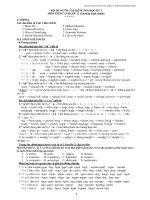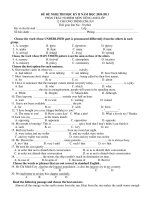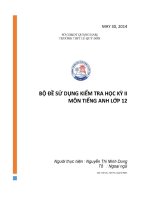Nội dung phần nghe tiếng anh lớp 12
Bạn đang xem bản rút gọn của tài liệu. Xem và tải ngay bản đầy đủ của tài liệu tại đây (92.24 KB, 6 trang )
NỘI DUNG NGHE TIẾNG ANH 12
Unit 1: HOME LIFE
PAUL: So, Andrea, you’re going home for the holiday?
ANDREA: I am sure. I’ve booked a flight for tomorrow afternoon and I can’t wait.
PAUL: That’s sounds great.
ANDREA: What about you? Going home too?
PAUL: I haven’t decided yet. I’m still considering …
ANDREA: Haven’t decided yet? Oh, you are never going to get a flight out of here. All the seats have been
reserved by now I’m sure. It’s the holiday season, after all.
PAUL: Well, it’s not very important to me. My family lives about 180 kms from here. I usually take the train or
the coach.
ANDREA: You don’t sound excited about it.
PAUL: Well, we are not really a very close-knit family. I have three brothers, and they’ve spread out all over the
place. We rarely get together as a family any more.
ANDREA: Well, try to get home as soon as possible. We’re a big family – there are six of us – children – so it’s
always a lot of fun.
PAUL: Six kids?
ANDREA: Yes. And we’re really close. My brothers are married, so it makes for a very crowded home over the
holiday. And there are too many people to cook for, so we end up going out to dinner a lot. That’s also fun.
PAUL: Well, at my home, my mother loves to cook, so when we get home she often cooks big meals. We have
leftovers for days.
Unit 2: CULTURAL DIVERSITY
TOURIST: Can you tell me about wedding ceremonies in VN?
TOURIST GUIDE: Well, wedding is very important to the Vietnamese, not only to the couple involved, but also
for the both families. The wedding day is usually chosen carefully by the groom’s parents.
TOURIST: What does the groom’s family usually do on the wedding day?
TOURIST GUIDE: On the wedding day, the groom’s family and relatives go to the bride’s house bringing gifts
wrapped in red paper. The people who hold the trays of gifts are also carefully chosen.
TOURIST: Do you have someone in charge of the ceremony? And what does he do during the wedding
ceremony?
TOURIST GUIDE: Yes, we have Master of Ceremonies who introduces the groom, the bride, the parents, the
relatives and guests of the two families. The wedding ceremony starts in front of the altar. The bride and the
groom would pray, asking their ancestors’ permission to get married. The Master of Ceremonies gives the
wedding couple advice on starting a new family. The groom and the bride then exchange their wedding rings.
TOURIST: Where is the wedding banquet held?
TOURIST GUIDE: Well, it depends. Often the wedding banquet is held at the groom and bride’s home or at the
hotel or a restaurant and all close relatives, friends, and neighbours are invited.
TOURIST: What kind of food and drinks are served?
TOURIST GUIDE: Traditional food and beer or vine are served. During the reception, the groom, bride, and
their parents stop by each table to thank their guests. The guests in return, will give envelopes containing
wedding cards and money to the newly wedded couples along with their blessing.
TOURIST: Oh. That’s very interesting. Thank you.
TOURIST GUIDE: You’re welcome!
Unit 3: WAYS OF SOCIALISING
The Telephone – Potential Family Battleground
Hello, everyone. In today’s talk I’m going to give you some pieces of advice on how to use the telephone in the
most decent way so as to avoid unnecessary disagreements between you and members of your family.
The telephone, as you know, is a marvelous instrument, but it may cause arguments between you and your
parents – arguments that could be easily avoided if you would sit down, talk it over, and agree to a few simple
regulations.
The most obvious problem, of course, is what everyone considers a reasonable length of time for a call. The
exact duration must be worked out with your parents, but ten minutes should be an absolute maximum. That’s
certainly long enough to say almost anything in five different ways, and yet it isn’t so long that other members of
the family will become angry. Even when your parents are out, the length of your call should be limited, because
they, or someone else, may be trying to reach your home for a very important reason.
1
Calling hours should be agreed upon. If your parents object to your leaving the dinner table to take calls, tell
your friends to avoid calling that hour; if someone does phone, ask him to call back, or offer to call him when
dinner’s over.
A serious calling problem is calling very late at night, or very early in the morning. This particular mistake is
made mostly by young people who consider 10 or 11 p.m., when a lot of tired adults are happily sleeping, the
shank of the evening. So please tell your friends not to call after ten o’clock. The shock of waking out of a sound
sleep and the fright of that instant thought – “There’s an accident” - are enough to give your parents a heart
attack. Weekend morning calls aren’t startling, but it’s the one time your parents can sleep late.
If your mother and father out of kindness, have installed a separate phone for you, remember that you’re still a
member of a family. So try to stick to your family’s regulations.
That’s all for my talk today. Thank you for listening.
Unit 4: SCHOOL EDUCATION SYSTEM
JENNY: Look, these questions about how you got on at school. Shall we just go through them?
GAVIN: Yes, let’s.
JENNY: Oh, so, did you always work very hard?
GAVIN: Well I certainly worked pretty hard at the subjects I enjoyed. Yes, I did. What about you?
JENNY: Yes, I did actually, I think I worked very hard, yeah. Now let’s come to the next question.
GAVIN: Did, yeah, did you always listen carefully to your teachers?
JENNY: No I don’t think I did. No, I think I was quite disruptive, actually. What about you?
GAVIN: Well I think I did listen to the teachers certainly when I got to the level where I was doing the subjects I
enjoyed.
JENNY: Yeah, OK, the next question is, did you always behave well?
GAVIN: I don’t think I always behaved well. I was, a bit, er, a bit of a tearaway.
JENNY: Um. Well, I think I was pretty well-behaved on the whole, so I’d say yes, yeah.
GAVIN: Good for you! Did you pass your exams easily?
JENNY: No I can’t say I did, no, I, I found them quite a struggle, actually. What about you?
GAVIN: I didn’t pass them that easily, though I worked hard I found it very difficult to answer all that long
questions in a short time.
JENNY: Yeah, yeah, exactly. What about this one, then? Did you always write slowly and carefully?
GAVIN: Quite slowly. Essays took a long time to write and I suppose I took a bit of care, yes.
JENNY: Yes, I agreed. I was also, I was very careful and erm, yeah, yeah I was quite methodical.
GAVIN: And did you think your school days were the best days of your life?
JENNY: Um, no, no I can’t say they were. What about you?
GAVIN: No, I went away to a boarding school when I was quite young and I didn’t like that. No, they weren’t
the best days of my life.
Unit 5: HIGHER EDUCATION
JOHN: Now, David, can I get this right: You’ve just completed a Msc course on which a large proportion of the
students were international students? Is that right?
DAVID: That’s it. Yes, I was in AERD – that’s the department of Agricultural Extension and Rural
Development.
JOHN: And how do you think the students from the other countries got along on that course?
DAVID: Pretty well.
JOHN: What advice would you give to students, particularly international students, based on your experience as
a student here?
DAVID: I think the most basic thing is to make use, full use, of the tutors and lecturers. Maybe some of the
overseas students are a bit shy to take questions or problems to tutors.
JOHN: What do you think they should do?
DAVID: I think they should find out at the beginning of the course the times at which the tutor is going to be
available for tutorial appointments, and then make full use of them.
JOHN: So, any problems, they should tell the tutor as soon as possible? Let’s move on, what about the amount of
reading that you have to do as a university student?
DAVID: Yes! It looks pretty daunting at first, with those long reading lists. Don’t think that students have to
read everything that’s listed. Try to find out which are the most important items on the list – ask the lecturer or
tutor if necessary, and then, if your time is limited, spend it reading those books thoroughly.
JOHN: OK, that’s very helpful, David. Thank you very much.
DAVID: No, not at all.
2
Unit 6: FUTURE JOBS
Let’s look at some of the recent changes in the US job market and see if we can make some predictions for future
jobs.
A good way to begin is to look at the American workforce and how it is changing. The most important change
has been the shift from manufacturing jobs to service jobs.
Manufacturing jobs are jobs in which people make something or produce things. For example, people produce
cars. Service jobs are those in which workers provide services, or we may say, they do something, like washing
people’s cars. Generally, service jobs are grouped into five categories:
One: Transportation companies.
Two: Wholesale companies.
Three: Retail companies.
Four: Finance companies.
Five: Personal services, such as hotels, cars repair, accounting, education and medicine.
Now the point here is that people have change from manufacturing jobs to service jobs. For example, 100 years
ago, 80% of workers produced goods, today only 30% do. Economists predict by the year 2020, nine out of
every ten workers will work in service jobs.
Unit 7: ECONOMIC REFORMS
The inhabitants of Tango, a small island in the Atlantic Ocean, discovered a plant which contained a powerful
drug. They grew the plant all over the island and they took the drug every day. This made it more difficult for
them to think rationally - it stopped them worrying about the future and enabled them to forget all their
problems. At the same time, it made it much easier for them to relax and enjoy themselves. And because of the
drug, the whole population of the island stopped working and spent all their time singing and dancing and
looking at the sea.
Unfortunately this had very bad effects on the country's economy. The workers and farmers became lazy, the
children didn't want to go to school and the whole population began to run short of food. This, however, didn't
discourage people from taking the drug. The Prime Minister made speeches on the TV warning them about the
drug, but nobody took any notice, and before long the economy of the country was in ruins. This forced the
Government to take measures. They introduced a law to make the drug illegal. But that only made the situation
worse. The law couldn't prevent the people from taking the drug. On the contrary, the fact that the drug was
illegal encouraged people to take it more. They put the drug-takers into prison. But this did not have any effect,
there were not enough prisons for them. Eventually, the Government found a solution: they exported the drug to
other countries. This saved the islanders from having to work more than one day a week and allowed them to
spend the rest of their time sitting in the sun without any care in the world.
Unit 8: LIFE IN THE FUTURE
Interviewer: Many scientists predict that in the 21st century people will be living into the incredible age of 130.
What do you think about this?
Dr. Davis: Well, I quite agree with them. They have reasons to be confident about that.
Interviewer: What are the reasons?
Dr. Davis: In fact, their prediction is based on research and on the fact that the centenarian population is
mushrooming as our general health improves.
Interviewer: Can you explain this further?
Dr. Davis: A century ago average life expectancy in Europe was 45. Today, providing we look after ourselves,
eat more healthily, cut down on things like butter, alcohol and cigarettes, we can add nearly 35 years to that
figure.
Interviewer: So these are the factors that help people live longer?
Dr. Davis: Yes. But the most important factor is the development in medical science.
Interviewer: What do you mean?
Dr. Davis: Nobody dies from old age, just from diseases that affect people when they get older.
Interviewer: So scientists are trying to find cures for fatal diseases like cancer and Aids?
Dr. Davis: Right. Nowadays, about 50% of cancers are curable, and I really believe that within 30 years this will
increase to 80%. And in ten years' time Aids will also be brought under control, too.
Interviewer: That sounds interesting. What about living forever?
Dr. Davis: So far, eternal life is just science fiction. But with the advance of science, it's not impossible.
Unit 9: DESERTS
3
Hello everyone. In today's talk, I'm going to tell you something about deserts, what they are and how they are
formed.
A desert is a hot, dry, sandy place. A desert is also a beautiful land of silence and space. The sun shines, the wind
blows, and time and space seem endless. Nothing is soft. The sand and the rocks are hard, and many of the
plants, such as the cactus, have hard needles instead of leaves.
The size and location of the world's deserts are always changing. Over millions of years, as climates change and
mountains rise, new dry and wet areas develop. But within the last 100 years, deserts have been growing at a
frightening speed. This is partly because of natural changes, but the greatest desert makers are humans.
In the 19th century some people living in English colonies in Australia got rabbits from England. Today there are
millions of rabbits in Australia, and they eat every plant they can find. The great desert that covers the centre of
Australia is growing.
Farming first began in the Tigris-Euphrates, but today the land there is a desert. In dry areas, people can plant
crops on dry and poor land. When there are one or two very dry years, the plants die, and the land becomes
desert.
In developing countries, 90 percent of the people use wood for cooking and heat. They cut down trees for
firewood. But trees are important. They cool the land under them and keep the sun off smaller plants. When
leaves fall from a tree, they make the land richer. When the trees are gone, the smaller plants die, and the land
becomes desert.
Humans can make deserts, but humans can also prevent their growth. Algeria planted a green wall of trees across
the edge of the Sahara to stop the desert sand from spreading. Mauritania planted a similar wall around its
capital. Iran puts a thin covering of petroleum on sandy areas and plant trees. Other countries build long canals to
bring water to the desert areas.
Well, that's all for my talk. Thank you for listening.
Unit 10: ENDANGERED SPECIES
For a long time the image most people had of a gorilla was a dangerous-looking animal with big, bared teeth. But
researchers studying gorillas show a very different picture of mountain gorillas. The animals are peaceful, gentle,
sociable, and mainly plant-eating creatures.
Gorillas live in family groups. A typical group is led by the biggest and strongest grown-up male gorilla. He is
called a silverback because the hair on a male's back turns from black to silvery grey as he grows up. A
silverback's group usually includes one or two sub-adult males and a few females and their young.
Mountain gorillas spend much of their time eating. Their food includes a variety of plants, along with a few
kinds of insects and worms. At night the animals make a nest to sleep in. Many lightweight gorillas nest in trees.
The heavier ones may nest in grasses on the ground. Babies sleep with their mothers at night.
Life for mountain gorillas is not always peaceful. They are endangered and threatened by civil wars in the
smaller parts of Africa. Hunters kill them for food. Their forests are cut down for farmland, fuel, and housing.
But many scientists, forest rangers and other concerned people are working hard to protect mountain gorillas and
their habitats.
Unit 11: BOOKS
I recently read The Incredible Journey by Sheila Bumford, a book about three animal friends who travel across
the Canadian wilderness looking for their owners. It is a fascinating story that describes some of the incredible
things animals can do.
When a Canadian family goes to England for a long trip, they leave their three pets with a friend who lives 300
miles away. Though well treated by the friend, the pets miss their family. One day, they are able to leave the
friend's house unnoticed and begin the long journey to find their owners. The central theme of the book, a
problem the animals must resolve, is how to survive life in the wilderness in order to arrive home. They never
could have completed the journey alone, but they take care of one another, and all the three make it and are
reunited with their owners.
Each animal has a distinct personality, but they care for one another almost as if they were a family. The most
impressive of them is the old dog. The journey was the most difficult for him, hut amazingly he found the
strength to make it.
The author didn't try to turn the animals into people, speaking and acting like humans. Instead she was faithful to
her characters as animals and showed us their journey through animal eyes. That made the book interesting and
unbelievable.
4
I would recommend the book to anyone who likes animals. I think that anyone who has ever had a pet or wanted
one would enjoy it.
Typed by Le Ngoc Thach, Thong Linh High School.
Unit 12: WATER SPORTS
SYNCHRONIZED SWIMMING
The great Australian swimmer, Annette Kellerman, student at the University of Wisconsin, planted the first seed
of what was to become synchronized swimming when she performed a water ballet in a glass tank in New York
in 1907.
Katherine Curtis, an American woman, was very inspired by the new water sport. So she tried to get
synchronized swimming added to the physical education programme for female students. In 1923 she founded a
water ballet club at the University of Chicago and sixty swimmers of the club attracted national and international
publicity.
The sport quickly became popular among young women in Chicago. Curtis developed the competition rules,
based essentially on the scoring methods used in gymnastics and diving.
The first recorded competition was held on May 27, 1939, between Chicago Teacher's College coached by Curtis
and Wright Junior College of Illinois.
Shortly afterwards, the Central Association of the Amateur Athletic Union (AAU) staged the first multi-team
competition on March 1, 1940. The following year, the AAU officially accepted synchronized swimming as a
competitive sport for team events. In 1946 the first formal national championships were conducted by the AAU.
Synchronized swimming became an Olympic event at the Los Angeles Games in 1984.
Unit 13: THE 22nd SEA GAMES
The first newspaper article:
Only Amnat won a gold in the Southeast Asian Games Pole Vaulting yesterday. Nobody else could clear the bar.
While he was the only one who stood alone on the podium, Amnat was among the Thai athletes who won 10
gold medals in early events yesterday. He won the gold in the Pole Vaulting Final after clearing 4.80 m.
Meanwhile four other pole-vaulters missed their attempts at the heights ranging from 4.40m to 4.80m. Amnat
has proved a lonely winner in this event, but his points were still below the SEA Games record of 5.05m.
The second newspaper article:
The Vietnamese Milk Company (Vinamilk) has offered jobs to the 27 members of Vietnam's Women's Football
Team after they won the Games' second title. Perhaps they are going to be milkmaids when they retire. It is not
an odd proposal because the majority of the footballers will become unemployed when the Games are over. And
they now have to struggle to make ends meet Vinamilk has promised to train their new employees as soon as the
deal is signed. The goalkeeper of Vietnam's Women's Football Team is dreaming to run a café after doctors have
said her injuries would stop her from playing ever again. At the moment, she is short of money, so the Vinamilk
offer looks tempting to her.
Unit 14: INTERNATIONAL ORGANIZATIONS
In 1945 leaders from 51 countries met in San Francisco, California and organised the United Nations (often
called the UN). World War II had just ended. Millions of people had died and there was destruction everywhere.
People hoped they could build a future of world peace through this new organisation.
The United Nations has four main goals and purposes:
1. To work together for international peace and to solve international problems;
2. To develop friendly relations among nations;
3. To work together for human rights for everyone of all races, religions, languages and of both sexes.
4. To build a centre where nations can work together for these goals.
Today almost every country in the world is a member of the UN. Each count signed an agreement that says:
• All members are equal.
• All members promise to solve international problems in a peaceful way.
• No member will use force against another member.
• All members will help the UN in its actions.
• The UN will not try to solve problems within countries except to international peace.
Obviously, the United Nations has not been completely successful in it. There have been several wars since
1945. However, the organization has helped bring peace to some countries that were at war. It has helped people
who left their countries because of wars. It has helped bring independence to colonies.
Unit 15: WOMEN IN SOCIETY
5
Women hold up half the sky. This is an old Chinese saying. However, research shows that perhaps women do
more than their share of “holding up the sky".
Fifty percent of the world's population are women, but nearly two-thirds of all working hours are done by
women. They do most of the domestic work like cooking and washing clothes. Millions also work outside the
home. Women hold forty percent of all the world's jobs. For this work they earn only 40 to 60 percent as much as
men, and of course they earn nothing for their domestic work.
In developing countries, where three-fourths of the world's population lives, women produce more than half of
the food In Africa, 80 percent of all agricultural work is done by women.
In parts of Africa, this is a typical day for a village woman. At 4.45 am, she gets up, washes, and eats. It takes
her half an hour to walk to the fields, and she works there until 3.00 pm. She collects firewood until 4.00 pm then
comes back home. She spends the next hour and a half preparing food to cook, then she collects water for
another hour. From 6.30 to 8.30 she cooks. After dinner, she spends an hour washing the dishes. She then goes to
bed at 9.30 pm.
Unit 16: THE ASSOCIATION OF SOUTHEAST ASIAN NATIONS
Mr. Hung: What are you doing? It’s so late. Why don’t you go to bed?
Nga: I’m trying to finish my essay about the culture and religions of the ASEAN countries. I’ll have to submit it
to my teacher tomorrow. May I ask you something, Dad?
Mr. Hung: Yes? What’s that?
Nga: Do you know how many people in Southeast Asia speak English?
Mr. Hung: I'm not sure. But the ASEAN region has the third largest number of English speakers -just after the
US and UK.
Nga: Really? Exactly how many people speak English?
Mr. Hung: Around 50 million, I think, … mostly in the Philippines.
Nga: Do you know anything about religions?
Mr. Hung: The ASEAN countries include three main religions. They are Islam, Buddhism and Catholicism.
Nga: What is Islam?
Mr. Hung: A religion based on a belief in one god and the teaching of Muhammad. It's the religion of the
Muslims.
Nga: Can you tell me something more about the Muslims?
Mr. Hung: It's an interesting question. The ASEAN countries have more Muslims than any other geo-political
entity.
Nga: But how many Muslims, Dad?
Mr. Hung: Oh, let me try to remember about a quarter of a billion, mostly in Indonesia and Malaysia.
Nga: And what about the other religions?
Mr. Hung: Other main religions of the various countries in the region include large numbers of Buddhists, and
Catholics in the Philippines.
Nga: What is the main religion in Vietnam?
Mr. Hung: It's Buddhism. Many people go to pagodas.
Nga: Well, and now I think I've got all the information I need for my essay. Thank you very much, Dad.
Mr. Hung: That's all right. Finish your writing and go to bed. I'm afraid you'll get up late tomorrow morning.
6









